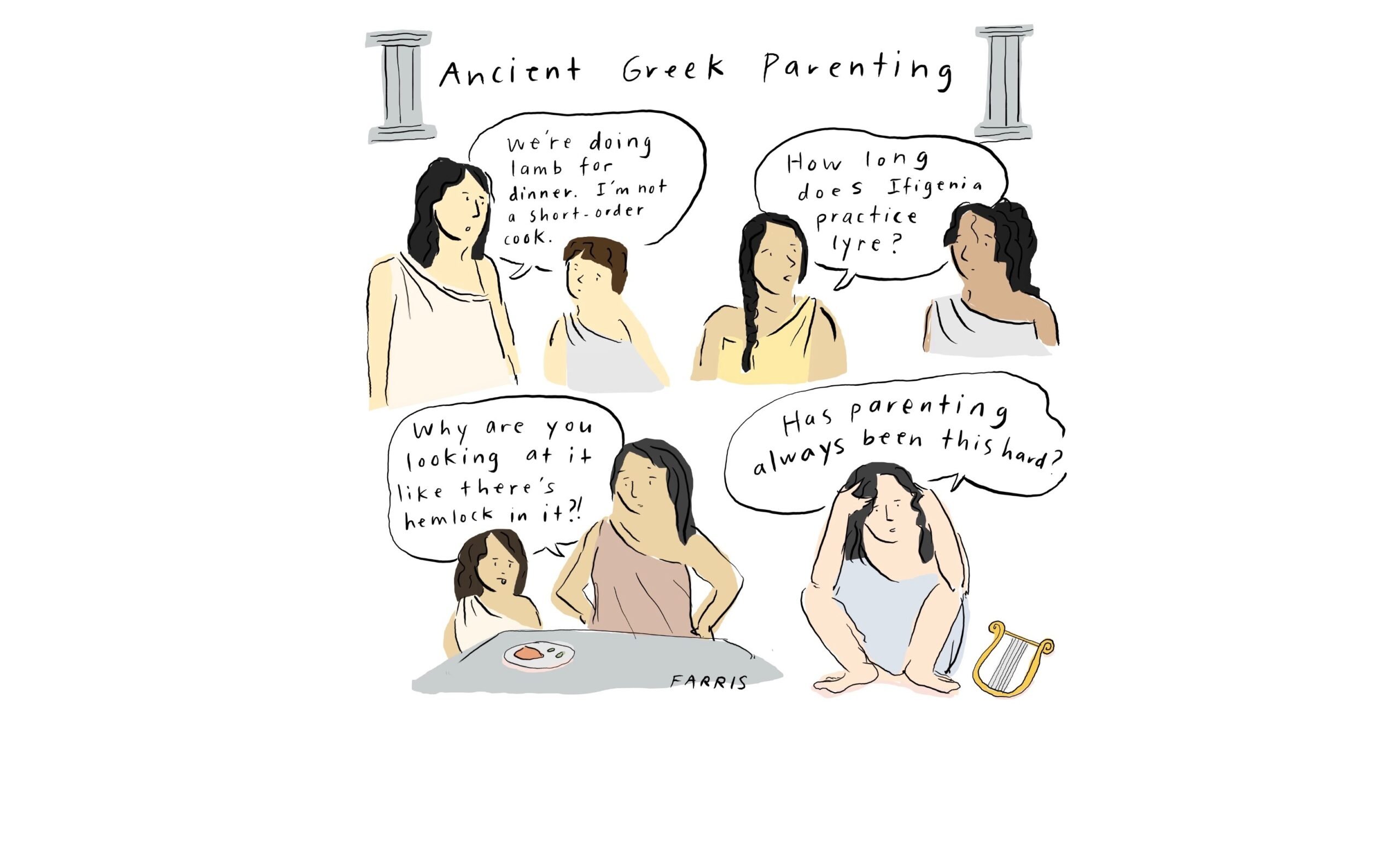Best of the Haiku Challenge (July 2024)
Announcing the winning poems from Tricycle’s monthly challenge The post Best of the Haiku Challenge (July 2024) appeared first on Tricycle: The Buddhist Review.

Announcing the winning poems from Tricycle’s monthly challenge
By Clark Strand Sep 07, 2024 Illustration by Jing Li
Illustration by Jing LiShade trees figured prominently in the lives of premodern people. Large, leafy trees with wide-set branches were used for a variety of purposes: as open-air meeting spaces, as cooling stations for livestock, and—when situated on private property—as places to nap or chat during the hottest hours of the day. In Buddhist countries shade trees have long been associated with monastic life. Until recently, it was still common to find Buddhist monks meditating (or even sleeping) beneath their branches while on pilgrimage. The winning and honorable mention poems for last month’s challenge explored both the sacred and secular aspects of this ancient symbol.
Jennifer Howse uses the image of a Bodhi tree growing to maturity to contemplate the history of early Buddhism.Daniel Sklar recalls a “childhood spent outside,” in which the exhilaration of tree climbing sometimes led to a fall.
Paula Fernandez’s shade trees are busy at work “folding sunbeams in their arms”—but they sometimes miss one.
Congratulations to all! To read additional poems of merit from recent months, visit our Tricycle Haiku Challenge group on Facebook.
You can submit a haiku for the current challenge here.
WINNER:
after a long while
the shade of the bodhi tree
begins to take shape
— Jennifer Howse
In 2023, the Metropolitan Museum of Art assembled a groundbreaking exhibition of more than 125 objects exploring Buddhist art in India from 200 BCE to 400 CE. Many of those objects—including statues, reliefs, pillars, cave paintings, reliquaries, stupas, medallions, and ritual vessels—were newly discovered, adding depth to our knowledge of early Buddhism. Until recently, that body of knowledge has been heavily biased toward written scriptures. The art adds to the story of Buddhism. Or it tells a different story. Or it tells the same story but in a different way.
As described by its curators, the purpose of “Tree & Serpent” was to present “a series of evocative and interlocking themes to reveal both the pre-Buddhist origins of figurative sculpture in India and the early narrative traditions that were central to this formative moment in early Indian art.” But if the museum’s patrons came expecting to find iconic representations of Shakyamuni Buddha seated in meditation under the Bodhi tree, they were surely disappointed. Only at the very end of the exhibit is one such figure displayed.
For over six hundred years after his passing into nirvana, the Buddha was represented aniconically, through images of a tree or a serpent, a set of footprints or an empty throne. The winning haiku for our July 2024 Haiku Challenge belongs to that older tradition.
The poem reads as a single sentence—an unassuming statement that becomes profound only when we consider the possible meanings of its opening line. Is the poet chronicling the history of a particular shade tree? Or is she describing the very tree under which Shakyamuni attained enlightenment … or perhaps the history of Buddhism itself, gradually taking shape over the centuries?
Ambiguity adds depth to a haiku, allowing the poet to layer various meanings, one on top of the other, so that the reader can experience them sequentially. Reading the verse in this way becomes like an archaeological excavation.
The poet imagines a Bodhi tree like the one the Buddha sat beneath. Or maybe she has traveled to Bodhgaya to see the descendant of the original tree. She considers how long it took to reach maturity. A century perhaps, but certainly not more than that. Which is not very long in the greater scheme of things. In this way she arrives at that simple but strangely evocative opening line: after a long while.
Paired with the image of a Bodhi tree, those five syllables become infinitely expandable. The words could indicate anything from a few decades to the many kalpas of practice and austerities it takes to become a buddha. The poem is a reminder that spiritual growth takes place slowly, and with great patience, over time.
And what of the poet’s decision to describe the shade tree rather than the Buddha? Is it a deliberate nod to the earlier, more animistic tradition that refused to limit buddhanature to the human realm? The answer is probably simpler than that. In its refusal to see human life as the be-all, end-all of existence, haiku belongs to a much older tradition in which even a tree can grow into a buddha.
HONORABLE MENTIONS:
Childhood spent outside,
climbing a shade tree, running,
broken arm sometimes.
— Daniel Sklar
shade trees at their work
folding sunbeams in their arms
one little beam falls
— Paula Fernandez
♦
You can find more on July’s season word, as well as relevant haiku tips, in last month’s challenge below:
Summer season word: “Shade Tree”
however often
i sit beneath this shade tree
i can’t use it up
Submit as many haiku as you wish that include the season word “shade tree.” Your poems must be written in three lines of 5, 7, and 5 syllables, respectively, and should focus on a single moment of time happening now.
Be straightforward in your description and try to limit your subject matter. Haiku are nearly always better when they don’t have too many ideas or images. So make your focus the season word* and try to stay close to that.
*REMEMBER: To qualify for the challenge, your haiku must be written in 5-7-5 syllables and include the words “shade tree.”
Haiku Tip: Write 10,000!
I asked my Japanese Zen master once if he had ever taken advantage of the fact that his own Zen teacher, Nakagawa Soen Roshi, was an acclaimed haiku poet trained by Iida Dakotsu, one of the greatest haiku masters of the 20th century. He said that he had asked Soen once what was required to “master” haiku, and Soen responded, “It’s easy! Just write 10,000!”
How exactly do you do that?
First of all, don’t get the idea that you have to write exactly 10,000. 10,000 just means a LOT of haiku. Too many to keep track of. So many that you completely lose count at some point and can’t even begin to say how many you’ve written.
And how do you do that?
To begin with…you keep writing haiku on a given theme until you get it right. Write 20 haiku on a single season word! Write 50…or even 100!
To do that requires two things: First, that you have a fixed form to work in—one that becomes more deeply imprinted on your mind the longer you work with it. Second, that you stay very loose and relaxed in working within that form.
Always, it is best to remain playful and creative. Don’t worry about getting it right on the first try. Or the second. Or the twentieth. Just keep going until you have a few poems you really like. Then submit those to the monthly challenge, or share them with a friend.
That’s how to write 10,000 haiku.
A note on shade trees: Season word editor Becka Chester says of this month’s topic: “Many trees function like an awning during the hot summer months. From the refuge provided by a quaking aspen to the shadowed shrouds offered by weeping willows, the cool space beneath them can be an oasis in the heat of day. In Haiku World, “William J. Higginson writes, ‘In winter we hope to bask in the sunshine; in summer we seek the shade of a tree.’”
![]()
Thank you for subscribing to Tricycle! As a nonprofit, we depend on readers like you to keep Buddhist teachings and practices widely available.

 ValVades
ValVades 
































.jpg?trim=0,0,0,0&width=1200&height=800&crop=1200:800)